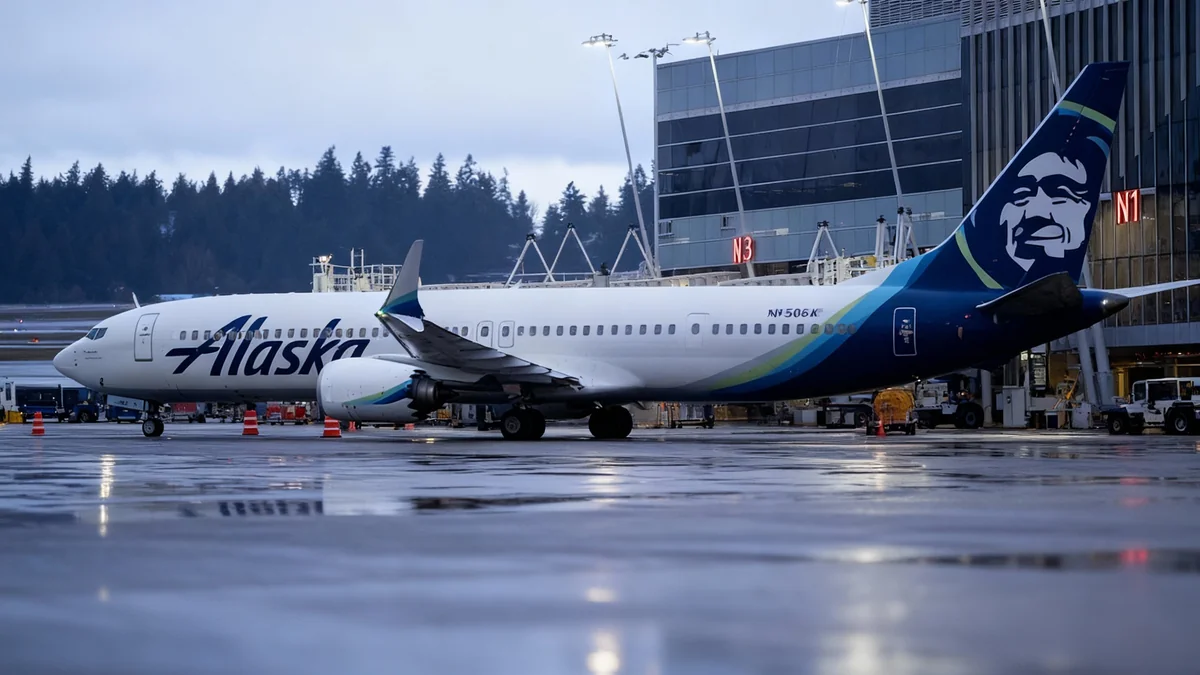Alaska Airlines is facing an estimated $26 million financial hit following a major IT outage last week. The incident grounded the airline's fleet for eight hours, disrupting travel for tens of thousands of passengers and leading to widespread flight cancellations. This marks the second significant system failure for the airline in recent months.
Key Takeaways
- Alaska Airlines' recent IT outage could cost $26 million.
- The incident grounded the fleet for eight hours, canceling 400 flights.
- This is the second major IT disruption since July, which cost $17 million.
- The airline is bringing in external experts to review its entire IT infrastructure.
- Ongoing government shutdown and rising fuel prices add further pressure.
Recent IT Failure Grounds Fleet
Last Thursday, a critical failure at Alaska Airlines' primary data center forced the airline to halt all flights. The grounding lasted from 3:30 p.m. to 11:30 p.m., impacting operations across its network. Approximately 400 flights were canceled, affecting over 50,000 travelers.
Operations returned to normal by Saturday, but the ripple effects of the disruption were felt for days. The airline acknowledged the severity of the situation, stating that this level of performance is unacceptable for their customers.
Outage Impact
- Duration: 8 hours
- Flights Canceled: Approximately 400
- Passengers Affected: Over 50,000
Financial Repercussions Estimated
Financial analysts are now calculating the cost of this latest IT incident. Savanthi Syth, an airline analyst with Raymond James, estimates the outage will reduce Alaska's earnings per share by about 15 cents. This translates to an estimated $26 million reduction in pretax income for the fourth quarter.
This figure highlights the significant financial vulnerability airlines face from operational disruptions. While Alaska Airlines has confirmed the costs of a previous July outage, they have not yet commented on the precise financial impact of last week's event, stating they are still investigating.
"It has been a string of bad news for Alaska," Syth wrote in a note to investors, referencing the tech troubles and other macroeconomic factors like rising fuel prices and visa policy changes.
A Pattern of IT Challenges
This is not the first time Alaska Airlines has faced a major IT system failure this year. In July, a hardware failure at one of its data centers grounded the fleet for three hours, leading to 200 flight cancellations. That incident cost the company about 10 cents per share, or roughly $17 million, from its earnings.
Following the July incident, Alaska Airlines stated they took steps to strengthen their IT systems. However, last week's outage demonstrated that more work is necessary. The company has not yet clarified if the two incidents are connected.
Background: July Outage
A previous IT outage in July resulted from a hardware failure. This incident led to a three-hour fleet grounding and 200 canceled flights, costing the airline an estimated $17 million. The company had pledged to improve its IT infrastructure after this event.
Seeking External Expertise for System Review
In response to both recent outages, Alaska Airlines announced plans to engage "outside technical experts." These experts will diagnose the airline's entire IT infrastructure. The goal is to ensure long-term reliability and prevent future disruptions.
Details about this process, including its timeline and potential outcomes, remain unclear. A spokesperson for the airline declined to share further specifics at this time, emphasizing the ongoing nature of the investigation.
Broader Financial and Operational Pressures
The recent IT outage occurred as Alaska Airlines reported its third-quarter financial results. Profits for the third quarter, which covers July through September, saw a significant dip. Net income fell from $236 million last year to $73 million this year. This decline was attributed to the first IT incident and challenging weather conditions on the East Coast.
Ryan St. John, Alaska’s vice president of investor relations, noted the operational difficulties during July. "The IT outage created a challenge for the operation, then every week there was something going on in the air traffic control system that just kept compounding on itself. All of that was unexpected," he explained.
The airline postponed a scheduled call with Wall Street analysts to discuss these earnings. This decision allowed employees to focus on supporting travelers and restoring operations.
Impact of Government Shutdown
Adding to the airline's challenges is the ongoing government shutdown. This situation affects air traffic controllers, who are working without pay. Members of the National Air Traffic Controllers Association plan to engage passengers at airports, including Sea-Tac, to raise awareness about the shutdown's impact on air travel.
While airlines typically budget for weather-related disruptions in the later months of the year, the combination of IT failures and the government shutdown presents a complex financial landscape. Analysts suggest that favorable weather in November and December could potentially help Alaska Airlines recover some lost ground.





